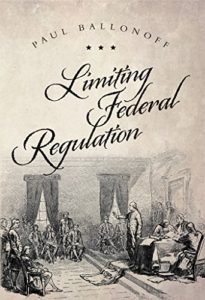Most Americans assume there are legal grounds for all of the federal government’s regulation of economic activity. But the reality is that aside from narrowly defined and limited powers, the feds lack any constitutional authority to control the broader economy, according to Paul Ballonoff in his book “Limiting Federal Regulation.”
At 121 pages, the book is a short but very intense exploration of a single section in the Constitution; the patent clause.
The clause reads as follows:
Congress shall have the power…to promote the Progress of Science and useful Arts, by securing for limited Times to Authors and Inventors the exclusive Right to their respective Writings and Discoveries.
Ironically, the word “patent” is actually not found in that clause at all. That is because the word had different meaning at the time the clause was penned than it does today, Ballonoff writes. Rather than grant the feds broad powers, he argues that the clause actually “profoundly limits the powers of the federal government” by denying it the general patent power formerly granted to the British crown.
“Except in very specific cases where the federal government has direct jurisdiction, the general patent power was prohibited to the federal government,” he writes. “Since the patent clause was the only form in which the federal government received any of the general patent powers, then the federal government is not only prohibited from creating forms of monopolies, but it is also prohibited from any acts in creating or managing the substance of commerce.”
Citing Justice Story’s commentaries on the constitutional, he demonstrates how “our term ‘general patent power’ refers to…a grant of any economic right by the government.”
“The possible part of the powers described by the ‘patent’ enumerates only a very specific form of that power,” he adds. “The Tenth Amendment reinforces this conclusion…. If a more general federal power had been intended, surely justices like Story, who were seeking to justify a more central federal power, would have made such an argument.”
Ballonoff later covers familiar grounds in critiquing claims that the general welfare clause grants the feds regulatory powers. As James Madison noted in Federalist 41, the preamble explained the need for enumerated federal powers. It did not give the feds carte blanche authority.
“Indeed, if the general welfare cause really was pregnant with such power, why then bother with a list of specifically enumerated powers at all?” Ballonoff writes. “The limits imposed on the federal government by the patent clause were not because the federal government should not act for the public good. It was because, if a government can act merely based on a claim of the public good, then a government can do anything without limit; it is always possible to create a claim of public good to justify any action. The colonists knew this from their own, and England’s bitter history, with powers of an absolute king.”
Analyzing the famous 1824 Supreme Court case Gibbons v. Ogden, Ballonoff observes that the ruling, while providing broad federal powers to open up markets under the interstate commerce clause, did not also conclude that it Congress had “unlimited powers over commerce” itself.
“Justice Marshall, like Justice Story, was clearly a nationalist seeking expansive federal powers, but both certainly understood that the constitution created no such unlimited federal positive power,” he writes.
For example, the 1995 Supreme Court case United States v. Lopez found that “the only subject matter of a congressional act ‘substantially affects’ interstate commerce is within the reach of the commerce clause,” he writes. “This argument therefore recognizes that the import of the Gibbons case was to limit subject matter jurisdiction of the commerce clause.”
 Going onto Munn v. Illinois in the latter half of the 19th Century, Ballonoff writes that the federal government was only able to consider the state’s actions under the commerce clause was because the state would “be regulating ‘virtual monopoly’.”
Going onto Munn v. Illinois in the latter half of the 19th Century, Ballonoff writes that the federal government was only able to consider the state’s actions under the commerce clause was because the state would “be regulating ‘virtual monopoly’.”
From direct controls on science and the environment to healthcare and utilities, “what we find is that the federal government has vastly expanded what it can do without the seeking of any constitutional amendment, and very often without any judicial interpretation that those powers are federal powers,” he writes. “The federal government does not have the power to create either single or multiple instances of specific forms of federal favored commerce.”
Although Ballonoff’s book is short, the scholarly content does not make for a light afternoon read. Several passages will probably require repeated re-reading in order to fully grasp the material. As a thoroughly research thesis against a major modern political shibboleth, “Limiting Federal Regulation” is ideal for the professional and amateur constitutional scholar looking to expand their knowledge and hone their arguments when making the case for a limited centralized government.
